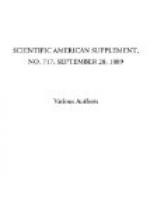[Illustration: FIG. 3.—SHIP OF THE NEW BALLET, THE “TEMPEST.”]
We come now to the details of construction of the vessel. It is not here a question of a ship represented simply by means of frames and accessories, but of a true ship in its entirety, performing its evolutions over the whole stage. Now, a ship is not constructed at a theater as in reality. It does not suffice to have it all entire upon the stage, but it is necessary also to be able to dismount it after every representation, and that, too, in a large number of pieces that can be easily stored away. Thus, the vessel of the Tempest, which measures a dozen yards from stem to stern, and is capable of carrying fifty persons, comes apart in about 250 pieces of wood, without counting all the iron work, bolts, etc. Nevertheless, it can be mounted in less than two hours by ten skilled men.
[Illustration: FIG. 4.—THE SHIP WITH ITS OCCUPANTS.]
The visible hull of the ship is placed upon a large and very strong wooden framework, formed of twenty-six trusses. In the center, there are two longitudinal trusses about three feet in height by twenty-five in length, upon which are assembled, perpendicularly, seven other trusses. In the interior there are six transverse pieces held by stirrup bolts, and at the extremity of each of these is fixed a thirteen-inch iron wheel. It is upon these twelve wheels that the entire structure rolls.
There are in addition the two bronze guide wheels that we have already spoken of. In the rear there are two large vertical trusses sixteen feet in height, which are joined by ties and descend to the bottom of the frame, to which they are bolted. These are worked out into steps and constitute the skeleton of the immense stern of the vessel. The skeleton of the prow is formed of a large vertical truss which is bolted to the front of the frame and is held within by a tie bar. On each side of this truss are placed the parallels (Figs. 1 and 3), which are formed of pieces of wood that are set into the frame below and are provided above with grooves for the passage of iron rods that support the foot rests by means of which the supernumeraries are lifted. As a whole, those rods constitute a jointed parallelogram, so that the foot rest always remains horizontal while describing a curve of five feet radius from the top of the frame to the deck of the vessel. They are actuated by a cable which winds around a small windlass fixed in the interior of the frame.




